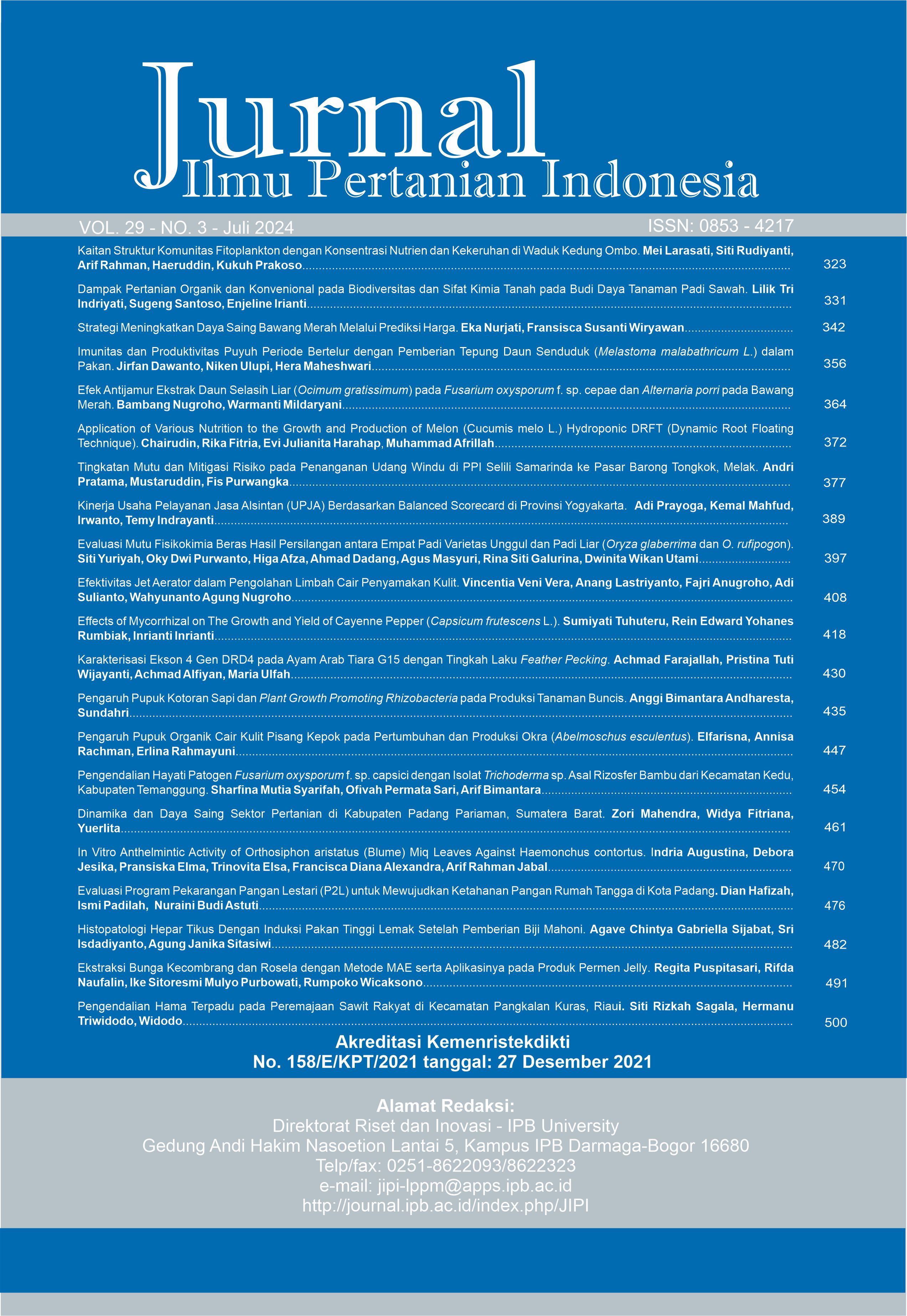Karakterisasi Ekson 4 Gen DRD4 pada Ayam Arab Tiara G15 dengan Tingkah Laku Feather Pecking
Abstract
Feather pecking (FP) is a potentially fatal behavioral disorder in chickens. Various factors, including genetics such as DRD4 gene, affected this behavior. The Arab TIARA G15 chicken is a laying hen breed selected based on FP behavior. However, genetic selection linked to this FP as not yet been conducted. This study aimed to characterize the 4th exon of the DRD4 gene in Arab golden red TIARA G15 chickens and confirm its potential as an FP genetic marker. The study used 30 TIARA G15 chickens that were divided into three groups: high feather pecking (HFP) (n = 10), low feather pecking (LFP) (n = 10), and control (n = 10). The DNA extraction kit extracted total genomic DNA from each blood sample. The 4th exon of the DRD4 gene was amplified using primer pairs MU140-141. Amplicons from samples within a group were pooled in a single tube and sequenced using the Sanger method. The sequencing results were analyzed for nucleotide variation using MEGA6 software. Nucleotide sequences obtained from each group were 642 bp, consisting of partial intron 3 (55 bp), full-length exon 4 (202 bp), and partial 3'UTR (385 bp). None of the three groups of Arab golden red TIARA G15 chickens were found to have any nucleotide variants in the partial intron 3, full-length exon 4, and 3'UTR regions of the DRD4 gene. Consequently, selecting the full-length exon 4 of the DRD4 gene for FP behavior was not feasible.
Keywords: arab chicken, DRD4, feather pecking, golden red
Downloads
References
Flisikowski K, Schwarzenbacher H, Wysocki M, Weigend S, Preisinger R, Kjaer JB, Fries R. 2009. Variation in neighbouring genes of the dopaminergic and serotonergic systems affects feather pecking behaviour of laying hens. Animal Genetics. 40(2): 192-199. https://doi.org/10.1111/j.1365-2052.2008.01821.x
Gillingham MAF, Bechet A, Geraci J, Wattier R, DubreuilC, Cezilly F. 2012. Genetic polyporphism in dopamine receptor D4 is associated with early body condition in a large population of greater flamingos, Phoenicopterus roseus. Molecular Ecology. 21(16): 4024-4037. https://doi.org/10.1111/j.1365-294x.2012.05669.x
Keeling L, Andersson L, Schutz KE, Kerje S, Fredriksson R, Carlborg O, Cornwallis CK, Pizzari T, Jensen P. 2004. Chicken genomics: feather pecking and victim pigmentation. Nature. 431(7009): 645–646. https://doi.org/10.1038/431645a
Kjaer JB, Hjarvard BM, Jensen KH, Hansen-moller J, Naesbye LO. 2004. Effects of haloperidol, a dopamine D2 receptor antagonist, on feather pecking behaviour in laying hens. Applied Animal Behaviour Science. 86(1–2): 77–91. https://doi.org/10.1016/j.applanim.2003.11.009
Komiyama T, Iwama H, Osada N, Nakamura Y, Kobayashi H, Tateno Y, Gojobori T. 2014. Dopamine receptor genes and evolutionary differentiation in the domestication of fighting cocks and long-crowing chickens. PLoS ONE. 9(7): e101778. https://doi.org/10.1371/journal.pone.0101778
Nozawa K. 1980. Phylogenetic studies on the native domestic animal in East and Southeast Asia. In: SABRAO Workshop on Animal Genetic Resources in Asia and Oceania. Tropical Agriculture Research Center Ministry of Agriculture Forestry and Fisheries, Tokyo.
Sabrina F. 2016. Kualitas telur ayam arab golden red (parent stock) pada periode puncak produksi pertama. [Skripsi]. Bogor (ID): Institut Pertanian Bogor.
Sanger F, Nicklen S, Coulson AR. 1977. DNA sequencing with chain-terminating inhibitors. Proceedings of the National Academy of Sciences. 74(12): 5463-5467. https://doi.org/10.1073/pnas.74.12.5463
Savory CJ. 1995. Feather pecking and cannibalism. World’s Poultry Science Journal. 51(2): 215–219. https://doi.org/10.1079/wps19950016
Tamura K, Stecher G, Peterson D, Filipski A, Kumar S. 2013. MEGA6: Moleculer evolutionary genetics analysis version 6.0. Molecular Biology and Evolution. 30(12): 2725–2729. https://doi.org/10.1093/molbev/mst197
Van Hierden YM, Korte SM, Ruesink EW, Van Reenen CG, Engel B, Kortebouws GA, Koolhaas JM, Blokhuis HJ. 2002. Adrenocortical reactivity and central serotonin and dopamine turnover in young chicks from a high and low feather-pecking line of laying hens. Physiology & Behavior. 75(5): 653–659. https://doi.org/10.1016/s0031-9384(02)00667-4
Copyright (c) 2024 Achmad Farajallah, Pristina Tuti Wijayanti, Achmad Alfiyan, Maria Ulfah

This work is licensed under a Creative Commons Attribution-NonCommercial 4.0 International License.
This journal is published under the terms of the Creative Commons Attribution-NonCommercial 4.0 International License. Authors who publish with this journal agree to the following terms: Authors retain copyright and grant the journal right of first publication with the work simultaneously licensed under a Creative Commons Attribution-NonCommercial 4.0 International License. Attribution — You must give appropriate credit, provide a link to the license, and indicate if changes were made. You may do so in any reasonable manner, but not in any way that suggests the licensor endorses you or your use. NonCommercial — You may not use the material for commercial purposes.






















